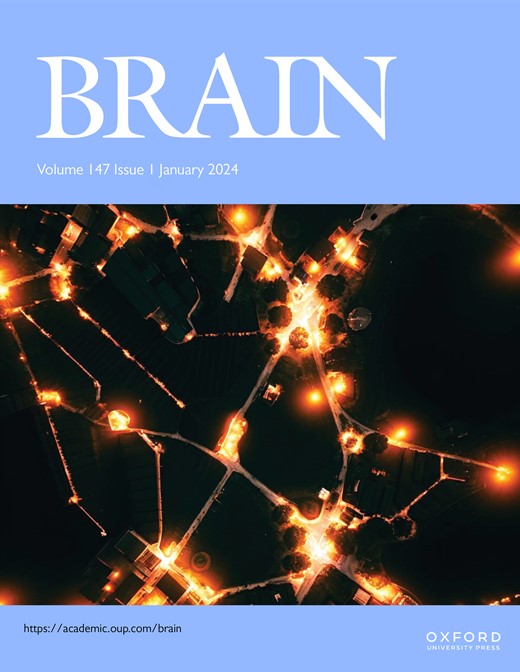Staging Alzheimer's disease through amyloid and tau PET.
IF 11.7
1区 医学
Q1 CLINICAL NEUROLOGY
引用次数: 0
Abstract
A workgroup assembled by the Alzheimer's Association recently described a conceptual framework for Alzheimer's disease biological staging based on amyloid and tau positron emission tomography (PET) imaging. However, specific tau PET cut points were left to be determined, a step necessary prior to clinical application. We sought to operationalize and evaluate Alzheimer's disease biological staging by identifying meaningful tau PET cut points to define the four biological stages in a well-characterized participant cohort and describe the features of individuals placed into the different biological stages. The primary analysis included 896 participants in the Mayo Clinic Study of Aging or the Mayo Clinic Alzheimer's Disease Research Center longitudinal cohorts. A validation cohort consisted of 328 participants in the Alzheimer's Disease Neuroimaging Initiative. Both cognitively normal and impaired individuals with positive amyloid PET and evaluable tau PET imaging were included. Tau PET cut points were identified with Gaussian Mixture Models to characterize Alzheimer's disease biological stage in study participants with different clinical diagnoses and objective degrees of cognitive impairment as measured by Mini-Mental State Examination. A tau PET cut point in the medial temporal region and two cut points in the temporoparietal region were identified to collectively produce the four Alzheimer's disease biological stages described in the revised criteria. Increasing stage was associated with greater likelihood of mild cognitive impairment and dementia diagnosis and worsening cognitive performance on Mini-Mental State Examination and Clinical Dementia Rating Sum of Boxes, a result that was reproduced in the independent Alzheimer's Disease Neuroimaging Initiative cohort. This study provided empiric validation for the concept of using amyloid PET and tau PET to separate subjects with biomarker-proven Alzheimer's disease into four biological stages with distinct characteristics.通过淀粉样蛋白和tau PET分期阿尔茨海默病。
由阿尔茨海默病协会组成的一个工作组最近描述了一个基于淀粉样蛋白和tau正电子发射断层扫描(PET)成像的阿尔茨海默病生物分期的概念框架。然而,具体的tau PET切点仍有待确定,这是临床应用之前的必要步骤。我们试图通过确定有意义的tau PET切点来定义一个特征良好的参与者队列中的四个生物学阶段,并描述处于不同生物学阶段的个体的特征,从而实现和评估阿尔茨海默病的生物学分期。主要分析包括来自梅奥诊所衰老研究或梅奥诊所阿尔茨海默病研究中心纵向队列的896名参与者。在阿尔茨海默病神经影像学倡议中,一个验证队列由328名参与者组成。包括具有淀粉样蛋白PET阳性和可评估的tau PET成像的认知正常和受损个体。采用高斯混合模型确定不同临床诊断和客观认知障碍程度的研究参与者的Tau PET切点,以表征阿尔茨海默病的生物学分期。内侧颞区的一个tau PET切点和颞顶叶区的两个切点被确定共同产生了修订标准中描述的四个阿尔茨海默病生物学阶段。阶段越长,轻度认知障碍和痴呆诊断的可能性越大,在迷你精神状态检查和临床痴呆评分方框总和中,认知表现越差,这一结果在独立的阿尔茨海默病神经影像学倡议队列中得到了重复。该研究为使用淀粉样蛋白PET和tau PET将生物标志物证实的阿尔茨海默病患者分为四个具有不同特征的生物学阶段的概念提供了经验验证。
本文章由计算机程序翻译,如有差异,请以英文原文为准。
求助全文
约1分钟内获得全文
求助全文
来源期刊

Brain
医学-临床神经学
CiteScore
20.30
自引率
4.10%
发文量
458
审稿时长
3-6 weeks
期刊介绍:
Brain, a journal focused on clinical neurology and translational neuroscience, has been publishing landmark papers since 1878. The journal aims to expand its scope by including studies that shed light on disease mechanisms and conducting innovative clinical trials for brain disorders. With a wide range of topics covered, the Editorial Board represents the international readership and diverse coverage of the journal. Accepted articles are promptly posted online, typically within a few weeks of acceptance. As of 2022, Brain holds an impressive impact factor of 14.5, according to the Journal Citation Reports.
 求助内容:
求助内容: 应助结果提醒方式:
应助结果提醒方式:


